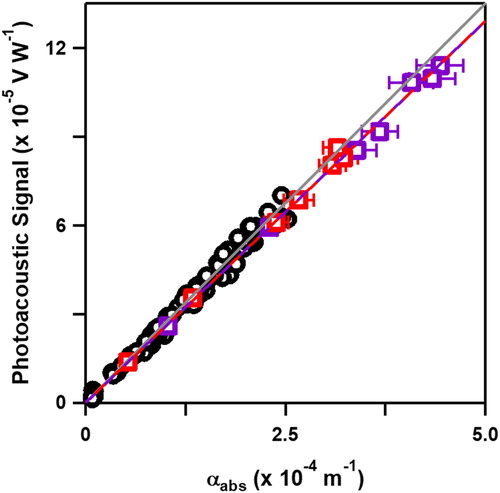Figures & data
Figure 1. Schematic of experimental design showing aerosol generation (black), classification (green), and spectroscopic characterization (red) where DMA = differential mobility analyzer, APM = aerosol particle mass analyzer, CPC = condensation particle counter, CRD = cavity ringdown spectrometer, PA = photoacoustic spectrometer. Parenthesis shows measurement performed, as described in text.
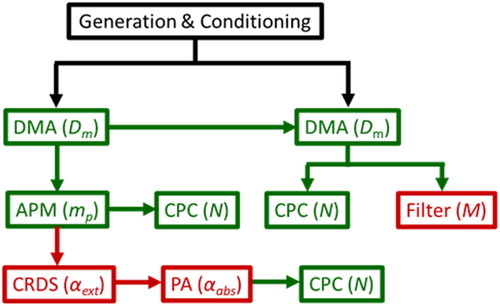
Figure 2. (a) X-ray photoelectron spectrum of a drop-cast CB thin film. Designated photoemission lines shown used for determination of elemental composition. (b) Flame ionization detector (FID) response (solid line) and temperature (dashed line) as a function of time (s) for Dm = 300 nm CB aerosol collected on a quartz filter. Temperature and atmosphere split between organic carbon (OC) and elemental carbon (EC) denoted by vertical dotted line. (c) TEM image of individual CB monomers from drop-cast aqueous suspension, scale bar is 50 nm. (d) aggregates observed from dilute suspension of CB drop-cast onto TEM grid, scale bar is 200 nm. (e) Atomized CB particles electrostatically deposited on lacey carbon grids. Scale bar represents 1 µm.
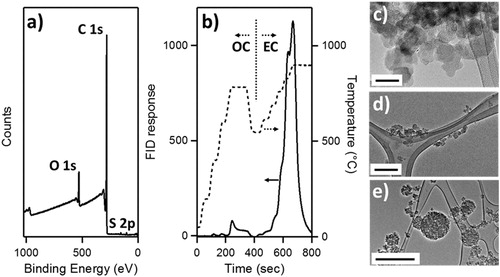
Figure 3. (a) Particle number concentration (# cm−3) as a function of Dm (nm) atomized from 0.25 (grey), 0.50 (blue) 1.0 (red), 2.0 (green), 4.0 (black) mg CB mL−1 aqueous CB suspensions. (b) Particle mass (fg, 10−15 g) as a function of Dm (nm) for 0.50 (blue), 1.0 (red), 4.0 (black) mg CB mL−1 aqueous CB suspensions. Dashed red line represents fit of 1.0 mg CB mL−1 aqueous CB suspension using EquationEquation (4)(4)
(4) . (c) Effective density (ρeff, g cm−3), calculated using EquationEquation (5)
(5)
(5) as a function of Dm (nm) for 0.50 (blue), 1.0 (red), 4.0 (black) mg CB mL−1 aqueous CB suspensions. Dashed red line represents linear best fit of 1.0 mg CB mL−1 aqueous CB suspension. Error bars are 1σ from a minimum of three measurements.
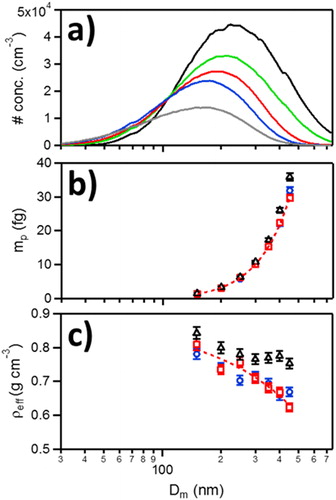
Figure 4. Measured spectroscopic data for Dm and mp-selected CB from atomization of 1.0 mg CB mL−1 aqueous CB suspensions. (a) Mass-specific absorption coefficient (MAC) as a function of wavelength for Dm = 150 nm (circles), 300 nm (squares), 450 nm (triangles) mobility, and mass selected aerosol, (b) MAC at λ = 532 nm (green) and 780 nm (black) as a function of Dm. (c) Ångström absorption exponent (AAE) using EquationEquation (6)(6)
(6) between λ = 405 nm and 780 nm as a function of Dm. (d) MAC (squares) and mass-specific extinction coefficient (MEC, circles) at λ = 405 nm (purple) and λ = 660 nm (red) as a function of Dm. (e) Single scattering albedo (SSA) at λ = 405 nm (purple triangles) and λ = 660 nm (red squares) nm as a function of Dm. Note that ordinate are identical in (a), (b), and (d). Uncertainties represent 1σ from >3 measurements and 2 production lots.
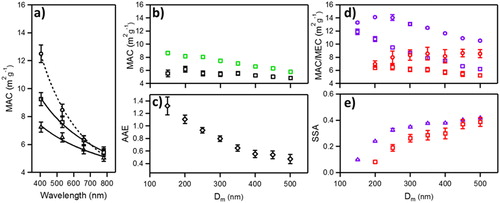
Table 1. The ensemble measured mp and MACT at λ = 405 nm, 532 nm, 660 nm, and 780 nm from aqueous 1.0 mg mL−1 CB suspension as a function of Dm for aerosolized CB.
Figure 5. (a) Aerosol mass concentration (M, ng m−3) of Dm and mp-selected CB measured by photoacoustic spectroscopy (MPAS) at λ = 532 nm (green circles) and 780 nm (black squares) vs. M measured by particle counting (MC). Dashed line represents 1:1. Uncertainties in MPAS represent propagated 1σ uncertainties in αabs and MAC while uncertainties in MC represent propagated 1σ uncertainties in mp and N, respectively. We assume a 5% particle counting uncertainty across all N. (b) Filter-based mass concentration (MF) vs. MC of Dm = 300 nm CB using the manufacturer’s (default) MATC of 16.6 m2 g−1 for λ = 880 nm radiation. Dashed line represents 1:1. Uncertainties in MF are ± 50 ng m−3 for filter-based measurements and for MC the same as defined in (a). Note the order of 24× difference in MC between (a) and (b).
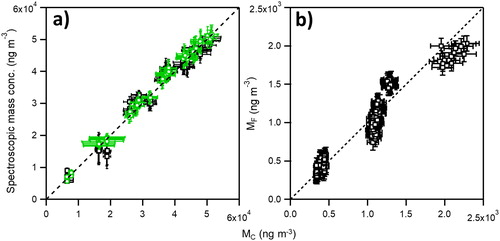
Figure 6. Photoacoustic microphone signal (V W−1) as a function of αAbs (m−1) for H2O vapor (black open circles) at λ = 725 nm and 820 nm and Dm and mp-selected CB at λ = 405 nm (open purple squares) and λ = 660 nm (open red squares). Dashed lines are linear fits of H2O vapor (black circles) and CB data (dashed red and purple). Uncertainties in x- and y- correspond to the standard deviations of multiple measurements and expanded uncertainties in calculated αabs; see discussion in text.
